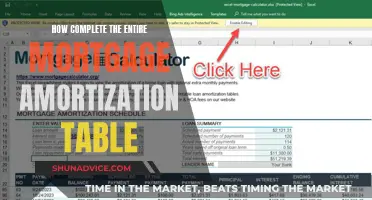
Assumable mortgages are an alternative way for buyers to finance a home purchase. Instead of applying for a new loan, the buyer assumes the seller's existing home loan, including its interest rate and repayment terms. This can be a cost-effective way to finance a home, especially when interest rates are rising. However, it can also increase the buyer's down payment. Most government-backed loans, such as FHA or VA loans, are assumable, while most conventional mortgages are not. Assumable mortgages were common before the 1980s but became less so after the passage of the Garn-St. Germain Act in 1982, which allowed lenders to enforce due-on-sale clauses.
Characteristics and Values of an Assumable Mortgage
| Characteristics | Values |
|---|---|
| Definition | When a buyer takes over the seller's existing loan, including interest rate and repayment terms |
| Purpose | To obtain an interest rate below the prevailing market rate |
| Common Types | FHA loans, VA loans, USDA loans |
| Requirements | Credit score of 580 or above for FHA loans, 620 or above for VA loans, 640 or above for USDA loans |
| Lender Approval | Typically required, except for VA loans closed before March 1, 1988 |
| Advantages | Cost-effective, no appraisal requirement, quicker and less expensive application process |
| Disadvantages | May increase down payment, potential for a second mortgage, strict rules and limitations |
| Eligibility | Buyer must meet lender's qualification standards and eligibility requirements |
What You'll Learn

Most government-backed loans are assumable
Most government-backed loans, such as FHA or VA loans, are assumable. However, most conventional mortgages are not. An assumable mortgage allows a buyer to take on the interest rate, repayment period, current principal balance and other terms of the seller's existing mortgage, rather than taking out a new loan. This can offer a better interest rate than what is available on the market. For example, if rates are rising, assuming an older mortgage loan can be a great way to secure a mortgage rate that is far below what you could qualify for if you applied for a new home loan.
FHA loans are assumable as long as the buyer meets the standard FHA loan requirements, including a credit score of at least 580 in most cases. VA loans can also be assumed without the buyer needing to be a member of the military or a veteran, and if the loan originated before 1988, it does not need to be lender-approved. However, if the loan was originated after 1988, any loan assumption must be lender-approved, and the buyer will have to pay the VA funding fee. USDA loans are most often assumed with a new rate and terms, and typically require a minimum credit score of 640.
While assumable mortgages can be a cost-effective way to finance a home purchase, they can also significantly increase the down payment. This is because an assumable loan rarely covers the full purchase price of the house, so the buyer needs to make up the difference. This can be done through a second mortgage, but these are riskier for lenders, and so typically only cover up to 85% of the value of the home.
Assumable loans could help break down barriers to homeownership for households with low and moderate incomes, but housing finance reforms are needed to ensure these loans can realise their full potential.
Monthly Mortgage: How Much Should You Be Spending?
You may want to see also

Most conventional mortgages aren't assumable
Most conventional mortgages are not assumable. An assumable mortgage is a type of home financing arrangement where an outstanding mortgage and its terms are transferred from the current owner to the buyer. The buyer becomes responsible for the loan at its existing interest rate and terms. Assuming a mortgage can be a cost-effective way to finance a home purchase, especially when rates are rising. However, it can also significantly increase the down payment.
There are a few reasons why most conventional mortgages are not assumable. Firstly, the mortgage contract usually contains a due-on-sale clause, which allows the lender to demand the entire remaining loan amount once the property is sold. This means that as soon as a buyer assumes the loan, they may be faced with a large bill from the lender. Secondly, an assumable loan rarely covers the full purchase price of the house, so the buyer needs to cover the difference, often through a second mortgage or a larger down payment.
Additionally, most conventional loans are not backed by the government, which is a key requirement for an assumable mortgage. Government-backed loans, such as FHA, VA, and USDA loans, are much more likely to be assumable. These loans often have more attractive terms, such as lower interest rates, which make them desirable for buyers. However, even with government-backed loans, there are typically eligibility requirements that the buyer must meet, such as a minimum credit score.
While most conventional mortgages are not assumable, there are special circumstances in which a conventional loan may be assumable. For example, up until the 1980s, assumable mortgages were the norm, and some loans originated before 1989 may still be assumable. Additionally, conventional adjustable-rate mortgages (ARMs) are usually assumable, although they cannot be assumed during the initial fixed-rate period or after being converted to a fixed-rate mortgage. Finally, in some cases, a simple assumption may be possible, which is a private transfer of responsibility for the mortgage from the seller to the buyer without the lender's approval. However, this is a much riskier transaction, as both the buyer and seller remain liable if the buyer fails to make payments.
My Mortgage Hardly Moved: What Gives?
You may want to see also

Pros and cons of assumable mortgages
An assumable mortgage is a home loan that can be transferred from the original borrower to the next homeowner. It is a cost-effective way to finance a home purchase, especially when interest rates are high. Here are some of the pros and cons of assumable mortgages:
Pros
Assuming a mortgage can be a good idea when interest rates are rising. If the loan has lower upfront fees, it can be an even better deal for the buyer. Buyers can take over the seller's mortgage and keep its interest rate, remaining payment schedule, and loan balance. This means the buyer can avoid obtaining their own mortgage, which may have a higher interest rate.
Additionally, the application process for an assumable mortgage is usually quicker and less expensive since an appraisal of the home is typically not required. The FHA, VA, and USDA also impose limits on closing costs when a mortgage is assumed.
Cons
Most mortgages are not assumable. Typically, only government-backed loans are assumable, and these loans may require the buyer to meet certain eligibility requirements, such as a minimum credit score. Additionally, an assumable loan rarely covers the full purchase price of the house, so the buyer needs to make up the difference, either with a second mortgage or a higher down payment.
Another potential disadvantage is that if the buyer falls behind on payments or breaches the mortgage agreement, the seller's credit and bank balance may suffer. This is especially risky if the assumption is done informally, without the lender's approval.
In summary, while assumable mortgages can offer significant savings, they also come with certain risks and limitations that buyers and sellers should carefully consider before proceeding.
Balloon Mortgages: Are They Common or Uncommon?
You may want to see also

The application process for an assumable mortgage
If you are assuming a mortgage from a close associate, you may not need the lender's approval, but this is a riskier option as the seller remains liable if you default on the loan. In most cases, the mortgage lender has to approve the assumption, and the new borrower must meet the loan's eligibility requirements. The buyer must confirm that the mortgage is assumable and meets the lender's criteria. The buyer then submits an application to the lender, including financial details for approval. The lender then assesses the buyer's creditworthiness and eligibility. If approved, the buyer and seller sign the assumption agreement, and the buyer takes on the loan. The transfer of ownership then takes place, and the seller is released from liability.
The process generally takes 60 to 90 days, depending on the lender and the specifics of the case. It is important to note that an assumable mortgage rarely covers the full purchase price of the house, so the buyer needs to cover the difference, potentially through a second mortgage or a larger down payment. Additionally, closing costs on assumed government-backed loans are cheaper than the 2% to 6% typically paid to close a loan.
Mortgage Industry in Texas: Size and Scope
You may want to see also

The history of assumable mortgages
Before this Act, assumable mortgages were common, and buyers could freely assume VA loans without needing approval from the lender or the VA. This meant that if someone bought a property with an existing VA loan, they would simply take over the loan with its existing terms and interest rate. This was advantageous for buyers, especially when interest rates were rising, as they could lock in a lower interest rate from an older loan.
However, after the Garn-St. Germain Act, VA loans originating after March 1, 1988, required lender approval for assumption. This change aligned VA loans with other types of assumable mortgages, such as FHA and USDA loans, which typically have specific requirements and criteria for assumption. For example, FHA loans require the property to be the seller's primary residence, and buyers must follow the standard FHA loan application process.
Despite the changes over time, assumable mortgages continue to offer benefits, especially in a high-interest-rate environment. They can provide lower interest rates, capped closing costs, and long-term savings compared to new mortgages. Additionally, assumable mortgages do not require appraisals, saving buyers money, and they can facilitate the transfer of assets within families without the need for lender approval.
Notarizing Mortgage Documents: The California Notary's Role
You may want to see also
Frequently asked questions
An assumable mortgage is when a buyer takes over the seller's existing home loan, including its interest rate and repayment terms. It is a cost-effective way to finance a home purchase.
Assumable mortgages are not very common. Only Federal Housing Administration (FHA) and U.S. Department of Veteran Affairs (VA) mortgages are assumable. United States Department of Agriculture (USDA) and conventional adjustable-rate mortgages (ARMs) may be assumable under specific conditions.
The biggest advantage of an assumable mortgage is that it offers a better interest rate than what is available on the market. It also does not require an appraisal, which can save buyers hundreds of dollars.







